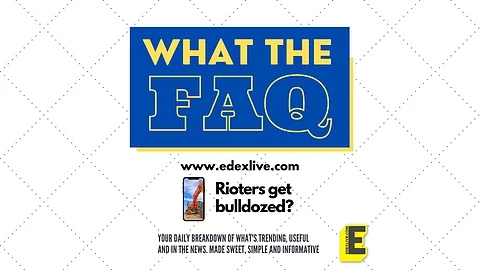

The demolition of houses and shops as part of the 'anti-encroachment' drive in Jahangirpuri, Delhi, comes on the heels of violence that hit the area on Saturday, April 16, during a Shobha Yatra on the occasion of Hanuman Jayanti.
Stones were pelted and clashes were reported between two communities, after which the police arrested 25 people. This fresh round of violence after a yatra adds to violence reported on Ram Navami on April 10 in Madhya Pradesh's Khargone, Jharkhand's Lohardaga, Rajasthan's Karauli, Gujarat's Himmatnagar, as well as in educational institutions such as the Central University of Karnataka and the Jawaharlal Nehru University, Delhi.
In Khargone, a day after the violence, the local administration demolished 16 houses and 25 shops, most of which belonged to the alleged rioters. "The houses of persons belonging to the SC community were set ablaze (by the rioters in Khargone). Why shouldn't action be taken against such people?" asked MP's Chief Minister Shivraj Chauhan, justifying the actions of the government.
In Jahangirpuri yesterday, the North Delhi Municipal Corporation (NDMC) bulldozed several "illegal structures" including houses, stalls, shops and even the gate of a mosque. This was announced as a "special joint encroachment removal action programme" in the area. On Tuesday, April 10, Delhi BJP President Adesh Gupta had written to the NDMC mayor to identify and demolish the illegal structures of those who had been arrested in connection with the violence on Saturday.
The drive was set to begin at 2 pm on Tuesday. The Supreme Court was petitioned early in the morning on Tuesday in the matter and Chief Justice of India, NV Ramana, ordered status quo in the area. However, the demolitions began earlier than scheduled at 9:30 am and despite the SC order coming in at around 10 am, they continued until after 12 noon, with the NDMC officials saying they did not receive a copy of the order.
The Supreme Court heard the matter today and the NDMC, much like the Khargone administration, said that the demolitions were a part of anti-encroachment drives that had already been scheduled and were not targetting anyone. The SC has ordered status quo in Jahangirpuri for two weeks when the matter will be next taken up.
In today's FAQ, we take a look at the legal questions surrounding the demolition of structures of alleged rioters.
Since when have properties of alleged rioters been demolished?
In 2019, after protests against the Citizenship Amendment Act (CAA) turned violent in Uttar Pradesh, Chief Minister Yogi Adityanath said that compensation from property damage will be extracted from those who participated in the riots, to the tune of Rs 50 lakh. He also announced that properties will be seized if people default on these payments. The UP administration accordingly issued notices to more than 100 people after this announcement.
What was the basis of such a decision?
India's Prevention of Damage to Public Property Act, 1984, is what governs actions taken against people convicted of rioting. However, this act levies a jail term and a fine on the offenders. In 2009, the Supreme Court had said that respective high courts can appoint benches to adjudicate on damages during protests and riots. In 2010, the Allahabad High Court had given the Uttar Pradesh government to form a body to accept damage claims, conduct a hearing and reach a conclusion in 30 days. In 2018, the Supreme Court had said that individuals will invite civil and criminal liability if found guilty of damaging public property.
What criticism did this announcement face?
From the legal perspective, the concept of a fair trial comes under question, since the government issued those notices before the people accused of participating in the riots were tried by any court. Senior advocates thus said that such a decision is unconstitutional and has no backing from the law. They also claimed seizure of property was being used as a means to curb dissent. In Madhya Pradesh and Jahangirpuri, the local governments demolished properties of those accused of participating in the riot, without an official investigation. They claimed in court, however, that the demolitions were a part of anti-encroachment drives that had been planned in advance and were not specifically targeting the alleged rioters.
Where does the case stand now?
The Supreme Court has extended its order of maintaining status quo and halting the demolition process for two weeks, when the matter will be listed for hearing again. The court was told today that the drive was a part of the pre-planned anti-encroachment action. However, the petitioners in the case claimed that they were communal and unlawful in nature. The Supreme Court has also said that it will take strict notice of the demolitions that continued on Tuesday even after its order of status quo was passed.
